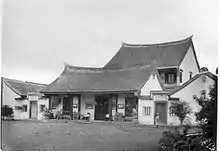Khouw family of Tamboen
The Khouw family of Tamboen (Bahasa Indonesia: 'Keluarga Khouw van Tamboen; Dutch: 'familie Khouw van Tamboen') was a bureaucratic and landowning dynasty, part of the Cabang Atas or the Chinese gentry of colonial Indonesia.[1][2][3]
| Khouw family of Tamboen | |
|---|---|
| Current region | Jakarta, Bekasi |
| Place of origin | Fujian, Qing Empire |
| Founded | 1769 (arrival in Java) |
| Founder | Khouw Tjoen |
| Members | Khouw Kim An, 5th Majoor der Chinezen Khouw Tjeng Tjoan, Luitenant-titulair der Chinezen KKhouw Tian Sek, Luitenant-titulair der Chinezen O. G. Khouw |
| Estate(s) | Candra Naya Gedung Juang Tambun Mausoleum O. G. Khouw |

Many members of the family held the rank of Majoor, Kapitein and Luitenant der Chinezen in the colonial government, which gave them significant political and judicial jurisdiction over the colony's Chinese subjects.[2][4][5] As among the colony's largest landlords (Dutch: landheeren; Bahasa Indonesia: tuan tanah), the family also played an important role in the urban, agricultural and economic development of the greater Jakarta area.[1][2][6]

The family traces its lineage back to Khouw Tjoen, a successful merchant who had migrated around 1769 from Fujian in China to Tegal on Java's north coast, thence to Batavia, capital of the Dutch East Indies.[2][3] On his death, he was succeeded by his son, Khouw Tian Sek (died in 1843), who later became the first member of the family to be raised to the honorary, but not substantive, rank of Luitenant der Chinezen.[2][7] In his Twentieth Century Impressions, the British journalist Arnold Wright attributes the family's rise to great wealth to Luitenant Khouw Tian Sek, whose landholdings in then semi-rural Molenvliet suddenly became prime urban property as the colonial capital expanded southwards in the early nineteenth century.[1] The family owned three extravagant Chinese compounds in Molenvliet, of which the only surviving one, Candra Naya, is now a major historic landmark in Jakarta.[3][6] Khouw also began the family's century-long association with the estate (particuliere land) of Tamboen, the most important of the many estates the family acquired around Batavia.[8] The family is also remembered today for their Art Deco country house, landhuis Tamboen (now id:Gedung Juang Tambun).[9]
Khouw's three sons, Khouw Tjeng Tjoan, Khouw Tjeng Kee and Khouw Tjeng Po, were − like their father − also elevated to the honorary rank of Luitenant der Chinezen.[2][3] By the late nineteenth century, the family's accumulation of dynastic land and wealth were among the largest and most significant in Batavia, if not the whole colony.[10]
The three brothers had many wives and children. A number of their children were pre-eminent community leaders in the late colonial era, including: Khouw Yauw Kie (died 1908), the family's first Kapitein der Chinezen and first representative on the Chinese Council; his cousin, Khouw Kim An, the last Majoor der Chinezen of Batavia (1875 - 1945); his brother, Khouw Kim Tjiang, Kapitein der Chinezen of Buitenzorg (now Bogor); and their cousin, the philanthropist O. G. Khouw (1874 - 1927).[2][11][12]
References
- Wright, Arnold (1909). Twentieth century impressions of Netherlands India: Its history, people, commerce, industries and resources. London: Lloyd's Greater Britain Pub. Co. Retrieved 1 December 2016.
- Erkelens, Monique (15 October 2013). The decline of the Chinese Council of Batavia: the loss of prestige and authority of the traditional elite amongst the Chinese community from the end of the nineteenth century until 1942 (PDF). Leiden: Leiden University. Retrieved 1 December 2016.
- Knapp, Ronald G. (2015). Chinese Houses of Southeast Asia: The Eclectic Architecture of Sojourners and Settlers. Singapore: Tuttle Publishing. ISBN 9780804844796. Retrieved 1 December 2016.
- Lohanda, Moha (1996). The Kapitan Cina of Batavia, 1837-1942: A History of Chinese Establishment in Colonial Society. Jakarta: Djambatan. ISBN 979428257X. Retrieved 1 December 2016.
- Blussé, Leonard; Chen, Menghong (2003). The Archives of the Kong Koan of Batavia. Leiden: BRILL. ISBN 9004131574. Retrieved 1 December 2016.
- Widayati, Naniek (2003). "Candra Naya Antara Kejayaan Masa Lalu dan Kenyataan Sekarang" [Candra Naya Between The Glory of the Past and The Present Reality]". Dimensi Journal of Architecture and Built Environment (In Indonesian). 31 (2). Retrieved 1 December 2016.
- "Javasche courant". Familiebericht (93). Landsdrukkerij. November 22, 1843. Retrieved 1 December 2016.
- "Soerabaijasch handelsblad". Het particuliere land Tamboen [The estate of Tamboen] (229). Kolff & Co. October 1, 1941. Retrieved 1 December 2016.
- "Gedung Juang '45, saksi Bisu Perjuangan Masyarakat Tambun [Hall of the Revolution of '45, Silent Witness to the Struggle of the People of Tambun]". Web Resmi Kecamatan Tambun Selatan [Official Website of South Tambun District]. Kecamatan Tambun Selatan [South Tambun District]. Retrieved 1 December 2016.
- Osterhammel, Jürgen (2014). The Transformation of the World: A Global History of the Nineteenth Century. Princeton University Press. p. 221. ISBN 9781400849949. Retrieved 2 February 2017.
- Setyautama, Sam (2008). Tokoh-tokoh etnis Tionghoa di Indonesia. Jakarta: Kepustakaan Populer Gramedia. ISBN 9789799101259. Retrieved 1 December 2016.
- Suryadinata, Leo (2015). Prominent Indonesian Chinese: Biographical Sketches (4th ed.). Singapore: Institute of Southeast Asian Studies. ISBN 9789814620505. Retrieved 1 December 2016.